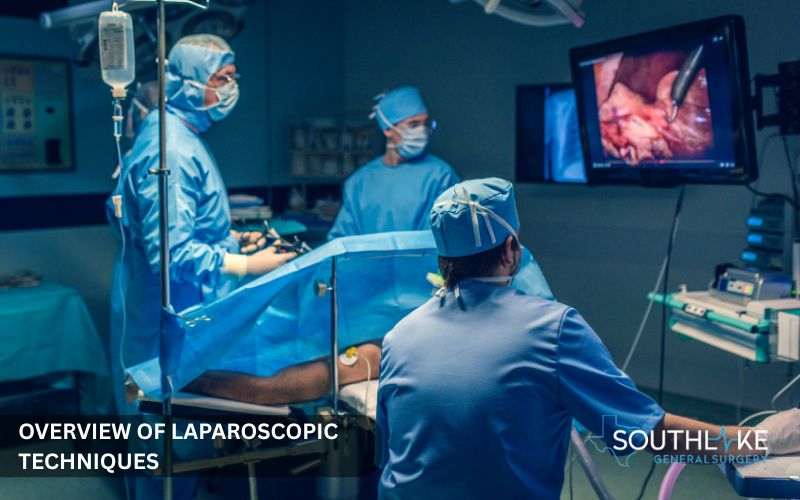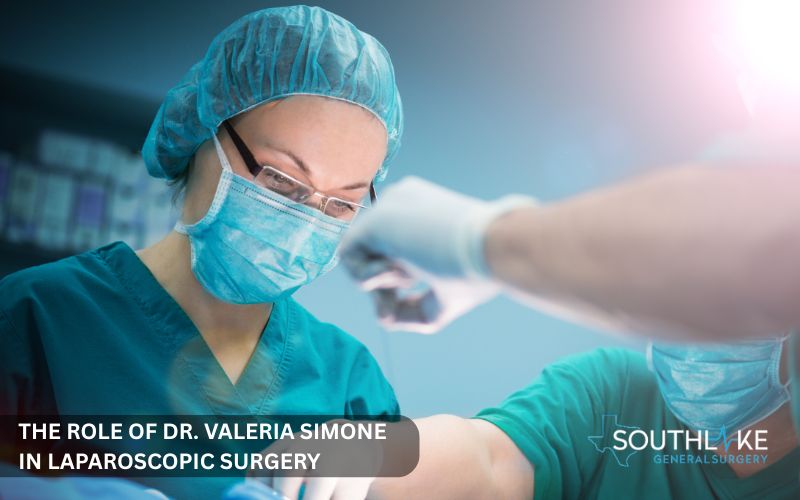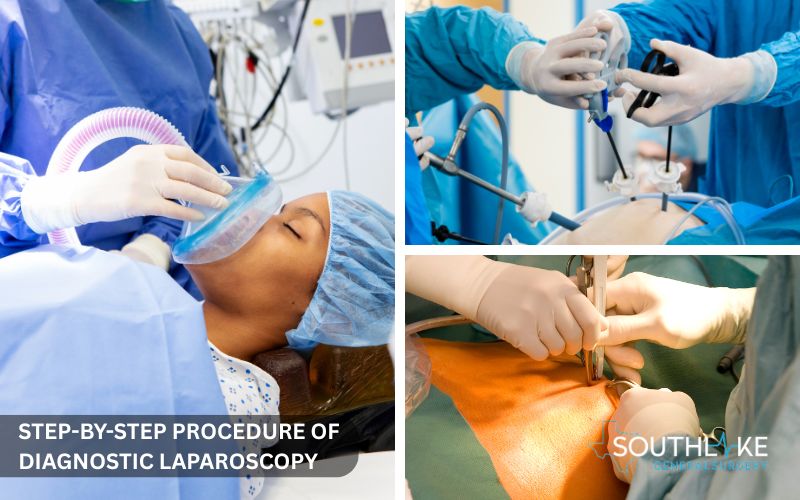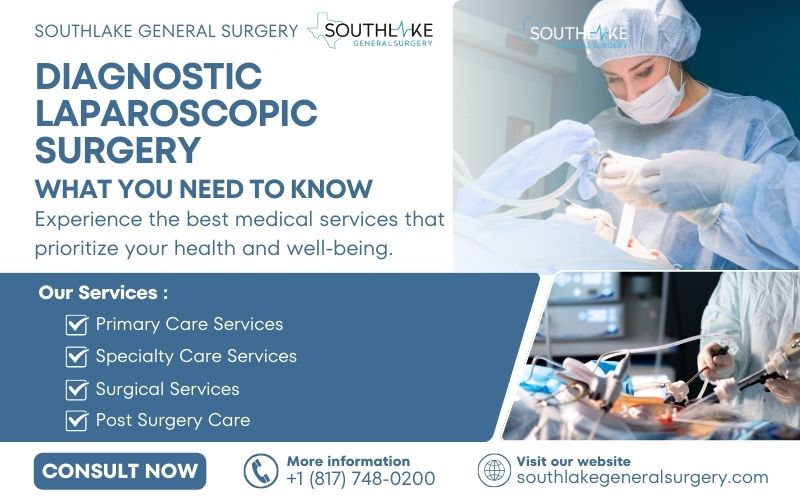Diagnostic laparoscopic surgery is a minimally invasive procedure that plays a crucial role in modern medicine. It enables surgeons to visualize internal structures of the abdomen and pelvis without large incisions, resulting in quicker recovery and less pain than traditional surgeries.
This technique has transformed the diagnosis and treatment of certain conditions. Diagnostic laparoscopic surgery involves making small incisions (0.5 to 1.5 cm) to access internal organs.
Diagnostic laparoscopy is a reliable approach employed by medical professionals. It lets them see into the abdominal or pelvic area. This technique has changed how doctors find and diagnose problems. They can discover and fix issues without making big cuts.
It is frequently suggested when ultrasounds or MRIs fail to provide definitive outcomes. Many patients and healthcare providers prefer this option because it is safe, accurate, and has a shorter recovery time.
Key Highlights
- Diagnostic laparoscopic surgery is a small operation that finds and treats issues in the abdomen or pelvis.
- It makes small cuts in the skin and uses a laparoscope with a video camera to see inside the body.
- This surgery often helps diagnose endometriosis, pelvic inflammatory disease, appendicitis, and unexplained abdominal pain.
- It allows patients to heal faster, leaves smaller scars, and has a lower risk of infections than regular open surgeries.
- Patients usually need general anesthesia, and the surgery is done on an outpatient basis.
Understanding Diagnostic Laparoscopic Surgery

Diagnostic laparoscopic surgery, like gynecologic laparoscopy, allows doctors to see inside the body. This helps them examine internal organs and spot problems. This type of surgery is effective for issues such as unexplained abdominal pain, gynecological concerns, and tumors. It usually provides better results than older surgical methods.
Patients enjoy this less invasive method because it requires just a few small incisions. This technique allows surgeons to quickly and effectively gather important information or fix problems, such as taking tissue samples.
Definition and Overview of Laparoscopic Techniques

A laparoscope is a surgical instrument used in laparoscopic procedures. This is a long, thin tube with a video camera inside. It helps doctors see internal organs through small incisions, which are usually less than half an inch. The surgeon can see real-time images of the abdominal area on a monitor. This makes it easier to find problems that could lead to infertility.
During the procedure, doctors fill the abdominal area with carbon dioxide gas. This makes more room inside, so they can see and move better. You may feel some shoulder pain as a side effect. They also put tools through small cuts. This helps them do biopsies or other small surgeries while checking things.
Small cuts hurt the tissues less than regular surgeries. This leads to a faster recovery and fewer scars. A quick recovery makes laparoscopic surgery a great choice for patients who want to get back to their daily activities fast. Laparoscopic procedures are important for many tests and treatments in modern medicine, including ones related to the bladder.
The Advancement of Laparoscopic Surgery in Modern Medicine
A significant breakthrough in modern surgical practices is laparoscopic surgery. It started as a way to find health issues over a hundred years ago. At present, it plays a vital role in minimally invasive surgery. Doctors use it for various diagnoses and treatments.
This technique has evolved significantly:
- It has changed from being only a diagnostic tool to a popular option for many health issues.
- It gives accurate results and causes less discomfort for patients.
- It
is often used in surgeries like:
- Gallbladder removal
- Hernia repair
- Cancer staging
With the advancements in science and technology, the tools utilized in laparoscopic surgery have seen significant improvements.
- Better cameras
- Enhanced surgical tools
- Safer methods to use carbon dioxide gas for insufflation
The progress in medical technology has allowed patients to heal more quickly. This shows just how vital laparoscopic surgery is in our healthcare systems today.
The Role of Dr. Valeria Simone in Laparoscopic Surgery

Dr. Valeria Simone is a skilled expert in laparoscopic surgery and truly cares about her patients. She is recognized for her cautious methods and her ability to use the latest techniques. Her top priority is safety, and she works hard to ensure the best results.
Over the course of her career, Dr. Simone has shown unparalleled dedication to the medical profession. She mainly works with diagnostic laparoscopy to address complicated abdominal pain and gastroenterologist problems.
Patients value her compassionate behavior and highly skilled approach. She is committed to using minimally invasive techniques for diagnosis and treatment.
Dr. Simone’s Expertise and Experience
Dr. Valeria Simone is a skilled expert in laparoscopic surgery. She has many years of experience using this method to find and treat different health problems. With advanced surgical tools, she carefully performs surgeries. As a result, accurate diagnosis and effective treatment are facilitated. Her knowledge includes conditions like endometriosis, fibroids, and abdominal pain that can be difficult to diagnose.
Dr. Simone is a reliable healthcare provider. She has great skills and offers caring support. Her main aim is to teach her patients. She explains their surgery options and the steps they will take. No matter if the case is simple or complex, she uses minimally invasive methods. This enables her patients to recover more quickly and achieve excellent outcomes.
People have faith in Dr. Simone. She combines her skills and knowledge with genuine care for her patients. This mix leads to excellent results in every laparoscopy she performs.
Benefits of Choosing Dr. Simone for Your Procedure
Patients who choose Dr. Valeria Simone for their laparoscopic surgery get several benefits, such as:
- Fast Healing: Her unique abilities in minimally invasive methods help you recover quickly. This way, you can return to your normal routine faster.
- Less Discomfort After Surgery: With minimally invasive techniques, you might feel less pain after your procedure.
- Smaller Scars: Laparoscopic surgery is very accurate, resulting in smaller scars compared to regular surgery.
Dr. Simone has a lot of experience. This means she gives care that is of very high quality. She offers:
- Clear Meetings: These meetings help make personal surgical plans that make patients feel safe.
- Kind Support: Her help continues after surgery. She offers full support and assistance during recovery.
Choosing Dr. Simone means you trust a healthcare provider who cares about getting the best results. She pays attention to:
- Safety: Always put the patient’s well-being first when doing surgery.
- Accuracy: Use reliable methods to achieve the best results.
- Patient Happiness: Focus on providing great care so patients feel happy with their experience.
Her commitment makes her a reliable choice for anyone needing laparoscopic surgery.
Preparing for Diagnostic Laparoscopic Surgery

Preparation is very important for having successful laparoscopic surgery. It begins with a meeting. During this meeting, your healthcare provider will review your medical history and symptoms. They will also schedule any tests that you might need.
Patients usually need to stay away from eating before their operation. They should wear loose and comfortable clothes. It’s also important to avoid certain medications or supplements.
Following these pre-operative steps can help make things easier and reduce the chances of issues. This can lead to better checks and a quicker recovery.
Initial Consultation: What to Expect
The first consultation is an important step before you have a diagnostic laparoscopy. Your doctor will do the following at this appointment:
- Understand the symptoms you are experiencing.
- Check your medical records and previous tests to find out if the surgery is necessary.
- You can share sensitive information that may affect the surgery, such as allergies or health issues.
The doctor may suggest doing some more tests. These might include:
- CT scans
- Ultrasounds
- Blood tests
These tests help us understand any problems that may be hidden.
Consultations are more than gathering information. They help you discuss any worries you may have. At this point, your doctor will:
- The laparoscopic procedure is a type of surgery that uses small cuts in the body. Through these incisions, a miniature camera and other specialized instruments are inserted. This lets the doctor see and work on the organs inside without making a big incision.
- During this procedure, the doctor will check or treat areas like the abdomen. There are several risks involved. These risks can include bleeding, infection, or injury to nearby organs. It is crucial to have a conversation about these risks with your doctor prior to the surgery.
- Recovery takes time, but it is usually faster than with open surgery. You may feel pain, but you can often control it with medicine. Pay close attention to everything your doctor says to help you get ready for the procedure. This may mean not eating or drinking before the procedure and stopping certain medicines.
Good communication during the consultation can lead to better results. If you’re anxious about the procedure, it might help as well.
Pre-Operative Instructions and Guidelines
Following the instructions before your surgery is very important for a successful diagnostic laparoscopy. This is particularly true for cleaning your bowels. Here are a few fundamental guidelines to remember:
- Fasting: Before surgery, patients usually need to fast. This means no food, drinks, or smoking starting the night before. Fasting helps reduce risks with anesthesia and makes surgery safer.
- Preparing the Abdomen: Keeping the area clean and following any extra steps from your healthcare provider can help prevent infections.
- Clothing: It’s best for patients to wear loose and comfortable clothes. This can make recovery easier after surgery.
- Medications: It’s important to tell your doctor about any medications, like blood thinners, aspirin, or supplements. You might need to stop some of them as advised. After surgery, you will go to the recovery room before heading home.
- Transportation: You should arrange for someone to drive you home after the surgery. Sedatives and anesthesia can affect your reflexes for several hours.
Following these steps can help you achieve better results. They also lower the chances of problems during and after laparoscopic surgery.
During the Surgery
Diagnostic laparoscopy is a precise method. First, patients are administered general anesthesia to ensure they remain at ease. After that, the surgeon makes small cuts in the abdomen. A laparoscope goes through these cuts to get a clear view of the organs.
The operating table includes safety features and new technology that help with accuracy. Once the surgery is finished, the cuts are closed. Following this, the patient moves to the recovery room. This approach highlights the benefits of using minimally invasive techniques.
Step-by-Step Procedure of Diagnostic Laparoscopy

During the diagnostic laparoscopy, there are several key steps that ensure everything is done correctly and safely:
- Preparation: The patient gets general anesthesia. This causes them to become numb and immobile.
- Initial Incision: A small cut is made near the belly button. By doing so, the doctor can access the abdominal cavity.
- Gas Insertion: Carbon dioxide is added to inflate the abdomen. This creates space for a better view inside.
- Laparoscope Insertion: A laparoscope, which has a video camera, is inserted next. This allows the physician to examine the internal organs.
- Exploration or Biopsy: The doctor might use some tools to take tissue samples or fix issues.
- Closure: All tools are removed, gas escapes, and the cuts are closed with sutures or adhesive.
These steps help you get the best diagnosis. Additionally, they help in minimizing pain and speeding up the healing process.
Safety Measures and Technological Advancements Used
Safety is very important during diagnostic laparoscopy. The operating tables help doctors see and reach the abdominal wall and area easily. New anesthesia methods make sure patients feel comfortable and protect their vital functions. To avoid problems, surgeons use high-definition cameras. These cameras give clear images of internal organs.
New technology improves these surgeries. Some of the changes are:
- Safer ways to use carbon dioxide reduce risks while doctors check organs.
- New laparoscopic tools help perform accurate surgeries that are less invasive.
- Safety measures include cleaning tools and using antibacterial sutures to reduce the chance of infections after surgery.
These helpful changes, along with careful surgical methods, ensure that safety and accuracy stay high during laparoscopic surgeries. This way of working shows a strong promise to use the newest medical technology. The goal is to enhance outcomes for patients while minimizing risks.
Post-Surgery: Recovery and Follow-Up
Recovery from laparoscopic surgery typically occurs more rapidly than healing from traditional surgical procedures. Patients may feel some mild discomfort, but doctors can easily manage it with pain medication. By following care instructions for the incision and taking it easy, you can lower the risk of complications.
Follow-up visits are key to checking your healing. They assist in resolving any issues and ensure that your recovery is on track. With good care, many patients can return to their daily activities in only a few days.
Expected Recovery Timeline and Tips
Generally, patients experience improvement following diagnostic laparoscopy within approximately a week. They may begin engaging in mild activities within a matter of days. Experiencing some discomfort around the incision sites post-surgery is completely normal.
There might also be some bloating from leftover gas. This discomfort can usually be taken care of with pain relievers from the doctor.
Here are some essential recovery tips:
- Keep the incision area clean: It’s important to maintain good hygiene to prevent infections.
- Avoid heavy lifting: Lifting heavy things can strain healing tissues.
- Eat a balanced diet: Nutritious foods support your recovery.
- Stay hydrated: Make sure to consume enough water to maintain proper hydration.
- Consume fiber-filled foods: Eating these can help with temporary constipation after surgery.
It’s important to watch your recovery timeline from your provider. If you feel discomfort that won’t go away or see signs of infection, like redness or strange swelling, you should contact your doctor right away.
By following these tips, patients can look forward to a quick and successful recovery, proving the benefits of laparoscopy.
Importance of Follow-Up Visits
Follow-up visits are very important after laparoscopic surgery. These moments are also an excellent opportunity to learn how to take care of yourself following a surgical procedure.
. During these outpatient visits, healthcare providers:
- Check the incision sites.
- Look for any discomfort.
- Review your overall recovery.
These appointments help patients share their symptoms, such as bloating, nausea, or tiredness. It allows for a look into whether these symptoms are normal during recovery. If issues like infection or slow healing arise, acting fast can prevent them from worsening.
Follow-up visits are not only for quick checks. These moments are also an excellent opportunity to learn how to take care of yourself following a surgical procedure.
These visits help patients feel sure about looking after themselves and getting back to their daily activities safely. In general, these appointments are important for speedy recovery. They help ensure that the surgery meets its goals.
Conclusion
The main points in this discussion highlight the value of diagnostic laparoscopic surgery in modern medicine. This includes procedures like cholecystectomy. Their minimally invasive characteristics result in reduced postoperative pain for patients and facilitate a quicker recovery when compared to traditional methods.
Surgeons use advanced laparoscopic tools, like a laparoscope and carbon dioxide gas, to carefully and safely look at the abdominal and pelvic areas.
Finding a qualified doctor, like Dr. Valeria Simone, is crucial for getting the treatment you need. This is especially true for conditions like endometriosis or pelvic inflammatory disease.
A healthcare provider’s strong knowledge of treatment, combined with the latest technology, helps patients feel better. It also builds their trust in the healing process.
Make an Appointment
To schedule a consultation, contact Dr. Valeria Simone, MD, at Southlake General Surgery in Texas, contact us at +1 (817) 748-0200. She has a lot of experience as a healthcare provider. Dr. Simone focuses on laparoscopic surgery. This type of surgery is useful for checking abdominal pain and other issues.
During your meeting, she will talk about different surgical procedures that might be needed. She can also help find problems like endometriosis or appendicitis.
Dr. Simone will give you advice on how to care for yourself after surgery. Don’t forget to bring your medical history. Be sure to ask any questions you have about anesthesia or recovery time.
Frequently Asked Questions
What benefits are associated with selecting diagnostic laparoscopic surgery?
Diagnostic laparoscopic surgery offers many advantages. It has a more subtle quality, making it gentler on the body. Patients feel less pain and have fewer scars due to the small incisions used in the surgery. This approach also results in a quicker recovery time and a reduced risk of complications compared to regular surgery. Additionally, it allows for an accurate diagnosis and treatment of various conditions.
How is the recovery process different for laparoscopic surgery compared to open surgery?
When compared to open surgery, the recovery time for diagnostic laparoscopic procedures is usually much shorter and considerably less painful. Patients usually experience smaller incisions, resulting in reduced scarring and quicker healing times. Most individuals can return to normal activities within a week, while open surgery may require several weeks for full recovery.
Medically Reviewed By: Dr. Valeria Simone MD
Board-certified General Surgeon at Southlake General Surgery, Texas, USA.
Follow us on Facebook and YouTube.
References:
- Odajima S, Ueda K, Hosoya S, Tomita K, Kato S, Shoburu Y, Kawabata A, Iida Y, Yanaihara N, Okamoto A. Clinical Availability of Tumour Biopsy Using Diagnostic Laparoscopy for Advanced Ovarian Cancer. In Vivo. 2021 Nov-Dec;35(6):3325-3331. doi: 10.21873/invivo.12629. PMID: 34697165; PMCID: PMC8627755.
- Afzal B, Changazi SH, Hyidar Z, Siddique S, Rehman A, Bhatti S, Ahmad QA, Farooka MW. Role of Laparoscopy in Diagnosing and Treating Acute Nonspecific Abdominal Pain. Cureus. 2021 Oct 13;13(10):e18741. doi: 10.7759/cureus.18741. PMID: 34796051; PMCID: PMC8589343.
- Okmen H, Ulusan K, Aren A. Is diagnostic laparoscopy necessary in the management of left thoracoabdominal stab wounds? Ulus Travma Acil Cerrahi Derg. 2023 Sep;29(9):1026-1031. doi: 10.14744/tjtes.2023.33423. PMID: 37681725; PMCID: PMC10560811.
- Peris A, Matano S, Manca G, Zagli G, Bonizzoli M, Cianchi G, Pasquini A, Batacchi S, Di Filippo A, Anichini V, Nicoletti P, Benemei S, Geppetti P. Bedside diagnostic laparoscopy to diagnose intraabdominal pathology in the intensive care unit. Crit Care. 2009;13(1):R25. doi: 10.1186/cc7730. Epub 2009 Feb 25. PMID: 19243621; PMCID: PMC2688143.
- Gotfried, J. (2025, January 10). Laparoscopy. Merck Manual Consumer Version. https://www.merckmanuals.com/home/digestive-disorders/diagnosis-of-digestive-disorders/laparoscopy

